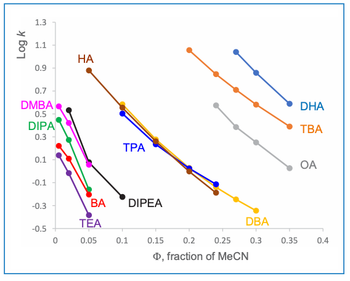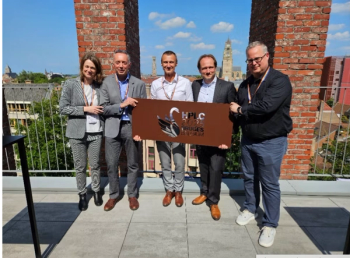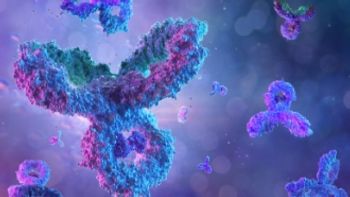
- HPLC 2025 Companion: Hot Topics in (U)HPLC
- Pages: 25–28
HPLC 2025 Preview: On The Road With Your Chromatograph?
Brett Paull from the University of Tasmania, Tasmania and his team describe the latest development in portable LC instruments and their experience of taking portable systems out to the field.
There has recently been a significant uptake in interest in small-footprint and compact high performance liquid chromatographs (HPLCs) that deliver portability and the potential for application to on-site and in-field analysis. There are a number of manufacturers currently producing liquid chromatographs, some of which are marketed as “portable,” including standard HPLC and variants thereof, that is, ion chromatography (IC). However, development of compact and self-contained liquid chromatographs is not a new phenomenon, and so-called “portable” HPLCs have been developed and reported upon since the early 1980s (1–2).
Some of these progressed to commercial systems but disappeared over time, while others remain only within the scientific literature, still standing testament to the belief of many analytical chemists that on-site analysis for certain applications overcomes the disadvantages of the traditional “grab (transport) and lab” approach.
Although these general developments are self-evident, there is currently some degree of contention amongst analytical chemists as to what merits being termed “portable.” In general, the term portability refers to the ease of mobility, and then additionally to its ease of installation and use on-site, which often, but not always, is benefited by a small and compact size.
With this in mind, our definition of portability of liquid chromatography—including when coupled to advanced detectors such as mass spectrometers—is rather less dominated by exact size and weight definitions, and more focused on transportability, self-sufficiency in remote settings, speed of installation and operation, and ability to deliver data on-site and in as close to real-time as possible. That said, compact and lightweight systems are obviously more transportable. Downsizing also often comes with reduced infrastructural requirements (gases, power), not to mention reagents (mobile phase) if downsizing of the actual chromatography itself is involved, for example, when moving to microbore or capillary. Combine these advantages and we arrive at a mobile capability, and when the target application is remote and beyond a short walk from the laboratory, we come to the emergence of a solution that looks very much like being a “lab-in-a-van.”
Environmental Analysis Using Portable Ion Chromatographs: Nutrient Monitoring
Over the past decade or more we have been interested in separation-based approaches to nutrient monitoring on-site and in the field. IC is the gold standard method for anion analysis, and as such a portable, self-contained, and even long-term deployable IC-based analyzer has considerable advantages to offer in this application space. Working closely with our research collaborators at Aquamonitrix, we have been exploring the development and application of portable IC-based technology in remote and wild regions of Tasmania, on water and on land, for environmental and agricultural nutrient monitoring (3–6).
A key challenge in this space is the simultaneous determination of ammonium, nitrite, and nitrate, which is essential for understanding the dynamics of the local nitrogen cycle. Currently, no single analytical method for monitoring these three important nutrient ions exists, particularly one which can be applied to real-time analysis, either out in the field or in static process applications (aquacultural applications). However, for this purpose, a modified system, containing two LED-based absorbance detectors, one deep-UV and the second at 660 nm, has been developed, which separates the two anionic species and detects them using direct UV absorbance, and uses post-column reaction chemistry to detect unretained ammonium ions, with absorbance detection in the visible region (4). With the two detectors running simultaneously, the system delivers two outputs for a single sample injection, one a simple anion exchange chromatogram (nitrite and nitrate) and the second, what is essentially a flow-injection analysis peak for the unretained ammonium cation. This modified portable chromatograph was used "out in field" locations across Tasmania, including multiple systems operating from the back of a field vehicle. In these examples, the systems are either being powered from a battery supply, a portable petrol generator, or from the vehicle itself. As this is an IC system, no bulk hazardous chemicals are required to be transported to site, as the system uses only a dilute NaCl eluent, with post-column reagents preinstalled. The system is also configured to run on a micro-bore format to reduce the reagent requirements for longer term deployment capability.
The spatial survey of fertilized agricultural paddocks for soil pore water levels of ammonia, nitrite, and nitrate was performed for a real pore water sample, extracted from a recently fertilized soil. Driving directly onto site and undertaking a full field survey after the previous day’s fertilizer application provides critical information on the short-term mobility and interconversion of these important nitrogen species, which, given the dynamic nature of the system, is not trivial when taking grab samples and transporting to a far-off laboratory for analysis, in a few days, or even weeks, time.
Field Screening of PFAS Using A Mobile LC–MS Platform (Lab-in-A-Van)
Per- and polyfluoroalkyl substances (PFAS), often referred to as “forever chemicals,” have garnered significant attention because of their environmental persistence, toxicity, and tendency for bioaccumulation (7,8). These synthetic chemicals pose potential severe health risks, including hormonal imbalances, reproductive issues, developmental delays, and increased risks of cancer (9). A high level of sensitivity and selectivity is essential for the detection of PFAS, which are typically present at trace levels in complex environmental samples, such as soils and sediments, necessitating mass spectrometry (MS) as the only suitable mode of detection for any field-based chromatographic methodology.
We have recently begun to investigate mobile solutions involving small-footprint LC–MS as an innovative solution for on-site PFAS detection. In a quintessentially Australian study, we deployed our “lab-in-a-ute” to nearby coastal sites and demonstrated on-site analysis for evaluating PFAS contamination using our mobile LC–MS-based solution (10). The motivation behind this was the delivery of a real-time capability, to facilitate quick decision-making for cases of potential site remediation, or to enable the efficient tracing of local contamination sources, and to reduce (or identify) the risks of sample contamination and degradation during grab sample shipping or storage. This on-site analysis capability can also save time and costs for clients and managers of potentially contaminated sites, by identifying only positive samples to be selectively shipped for centralized laboratory analysis.
A new contribution to compact and deployable “at-sample measurement” technology has been introduced (11–13). This is a compact self-contained capillary LC system, with full gradient capability and a back pressure threshold approaching 5000 psi. We have recently begun developing methods using this system coupled with a similarly compact single quadrupole mass spectrometer for on-site PFAS analysis. In the most recent method developed, this hyphenated system can deliver rapid PFAS screening, with a 6.5-min sample runtime, quantifying 10 prevalent PFAS compounds in extracted soil and natural water samples.
To transport this solution to sites of interest, Trajan Scientific and Medical introduced a “Mobile PFAS Screening Platform” (lab-in-a-van) equipped with the LC–MS systems and furnished with essential sample preparation tools. In partnership with ADE Consulting Group, this mobile LC–MS PFAS lab recently undertook a 10-day roadshow across Victoria, New South Wales, and Queensland—covering over 3000 kms, visiting 10 sites, analyzing more than 200 environmental samples on-site, and simultaneously conducting comparative analysis with commercial laboratories.
During this field study, several challenges and learnings became evident to consider going forward. First, unlike most readers of this article, field-based clients were simply focused on a simple report of µg PFAS per kg soil rather than any of the technical wizardry. Second, a major consideration for all field-based analysis is sample preparation, and there is clearly now a need for similarly compact and mobile (and if possible automated and integrated) sample preparation technology to reduce manual handling errors, increase throughput, and improve analytical precision. A further important consideration is ensuring system robustness in remote locations, particularly in the case of LC–MS, covering everything from the stability of power and gas supplies, to instrumental drift, to ease of on-site troubleshooting, and quality control. At the very least, particularly when you are more than 1000 km from your home laboratory, it’s also good to have a home team available for remote support and troubleshooting, as was the case for the away team here when confronted with system communication errors!
References
(1) Rahimi, F.; Chatzimichail, S.; Saifuddin, A.; et al. A Review of Portable High-Performance Liquid Chromatography: The Future of the Field? Chromatographia 2020, 83, 1165–1195. DOI: 10.1007/s10337-020-03944-6
(2) Hemida, M.; Ghiasvand, A.; Macka, M.; Recent Advances in Miniaturization of Portable Liquid Chromatography with Emphasis on Detection. J. Sep. Sci. 2023,46, 2300283. DOI: 10.1002/jssc.202300283
(3) Mai, Y.; Ghiasvand, A.; Gupta, V.; et al. Application of a Portable Ion Chromatograph for Real-time Field Analysis of Nitrite and Nitrate in Soils and Soil Pore Waters. Talanta2024,274, 126031. DOI: 10.1016/j.talanta.2024.126031
(4) Debruille, K.; Mai, Y.; Hortin, P.; et al. Portable IC System Enabled with Dual LED-based Absorbance Detectors and 3D-printed Post-column Heated Micro-reactor for the Simultaneous Determination of Ammonium, Nitrite and Nitrate. Anal. Chim. Acta 2024,1304, 342556. DOI: 10.1016/j.aca.2024.342556
(5) Fitzhenry, C.; Jowett, L.; Roche, P.; et al. Portable Analyser Using Two-dimensional Ion Chromatography with Ultra-violet Light-emitting Diode-based Absorbance Detection for Nitrate Monitoring Within Both Saline and Freshwaters. J. Chromatogr. A 2021, 1652, 462368. DOI: 10.1016/j.chroma.2021.462368
(6) Murray, E.; Roche, P.; Briet, M.; et al. Fully Automated, Low-cost Ion Chromatography System for In-situ Analysis of Nitrite and Nitrate in Natural Waters, Talanta2020,216, 120955. DOI: 10.1016/j.talanta.2020.120955
(7) Wee, S. Y.; Aris, A. Z. Environmental Impacts, Exposure Pathways, and Health Effects of PFOA and PFOS. Ecotoxicol. Environ. Saf. 2023, 267, 115663. DOI: 10.1016/j.ecoenv.2023.115663
(8) Wang, Y.; Darling S. B.; Chen, J. Selectivity of Per- and Polyfluoroalkyl Substance Sensors and Sorbents in Water. ACS Appl. Mater. Interfaces 2021, 13, 60789–60814. DOI: 10.1021/acsami.1c16517
(9) United States Environmental Protection Agency, USEPA, Our Current Understanding of the Human Health and Environmental Risks of PFAS, Date last updated: 26 November 2024. https://www.epa.gov/pfas/our-current-understanding-human-health-and-environmental-risks-pfas (accessed 2025-04-29).
(10) Hemida, M.; Ghiasvand, A.; Gupta, V.; et al. Small-footprint, Field-deployable LC/MS System for On-site Analysis of Per- and Polyfluoroalkyl Substances in Soil. Anal. Chem. 2021, 93, 12032–12040. DOI: 10.1021/acs.analchem.1c02193
(11) Coates, L. J.; Lam, S. C.; Gooley, A. A.; et al. Modular, Cost-effective, and Portable Capillary Gradient Liquid Chromatography System for On-site Analysis. J. Chromatogr. A2020,1626, 461374. DOI: 10.1016/j.chroma.2020.461374
(12) Hemida, M.; Haddad, P. R.; Lam, S. C.; et al. Small Footprint Liquid Chromatography-Mass Spectrometry for Pharmaceutical Reaction Monitoring and Automated Process Analysis. J. Chromatogr. A 2021,1656, 462545. DOI: 10.1016/j.chroma.2021.462545
(13) Mikhail, I. E.; Lam, S. C.; Coates, L. J.; et al. Determination of Haloacetic Acids in Municipal Tap Water and Swimming Pool Water Using Portable Capillary Liquid Chromatography – Mass Spectrometry. J. Chromatogr. A2025,1751, 465941. DOI: 10.1016/j.chroma.2025.465941
Biographies
Brett Paul is a BSc, PhD, and DSc graduate of the University of Plymouth, UK, and a professor of analytical chemistry at the University of Tasmania. His research sits at the interface of materials and analytical science, with a focus on analytical platform technologies to explore industrial and environmental systems. He is currently director of the ARC Training Centre for Hyphenated Analytical Separation Technologies (HyTECH), a multi-partner industry supported research centre focused on analytical technology developments to meet complex end-user challenges.
Kurt Debruille is a chemist and researcher specializing in environmental analysis and microfluidic technologies. After a career in the automotive industry, he transitioned to science, earning a bachelor’s degree in chemistry in 2017 and a master’s in biochemistry in 2019 from the University of Mons, Belgium. In 2022, he began a PhD at the University of Tasmania, developing 3D-printed microfluidic detection devices for remote nutrient analysis in water using a portable ion chromatography system. His research also includes soil nutrient analysis to investigate the interactions between land and water quality.
Ibraam Mikhail is a postdoctoral research fellow at the ARC Training Centre for Hyphenated Analytical Separation Technologies (HyTECH) at the University of Tasmania, Australia. He obtained his PhD in chemical sciences from the University of Tasmania in 2020. His current research, conducted at the interface of academia and industry, focuses on developing sensitive and efficient methodologies for monitoring emerging environmental contaminants in soil and water samples using portable analytical technologies. In addition, his work explores various applications of mass spectrometry in bioanalysis and environmental monitoring.
Andrew Gooley is a career scientist with over 45 years’ experience in both academia and industry. Since 2013 he has held the role of chief scientific officer at Trajan Scientific and Medical and leads a multidisciplinary team of scientists and engineers on a diverse range of projects, from medical device development through to consumables, components, and integrated systems for the global analytical science community. He has been responsible for the execution of a range of collaborative programs with the Australian academic and medical research community focused on the translation of research outcomes into new product development.
Shing Chung (John) Lam is a process analytical research scientist at Trajan Scientific and Medical. After graduating from the University of Tasmania, Lam joined Trajan in 2020 to provide technical leadership in the company’s LC and LC–MS projects, as well as application and technical supports to Trajan’s customers. He is currently a technical application lead in the Trajan’s portable LC–MS program.
Articles in this issue
8 months ago
HPLC 2025 Preview: HPLC 2025 Hits BrugesNewsletter
Join the global community of analytical scientists who trust LCGC for insights on the latest techniques, trends, and expert solutions in chromatography.




